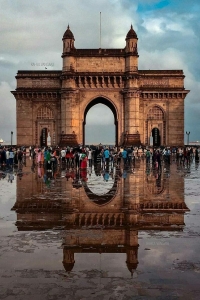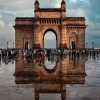
Prague, a brooding movie released some time back, had a thoughtful tagline, “Men live in cities. Sometimes, cities live in men too.” This makes complete sense. The world is replete with cities which grow on an interested observer, and indeed get embedded in thought.
I first experienced Bombay/Mumbai through the tinted lens of Bollywood. It was the city of dreams, where orphaned boys polished shoes at railway stations and grew up to be swaggering overlords of the city’s underworld. It was the city of the Bandra Fast where a bumbling cartoonist fell in love with a gorgeous daily passenger. It was the city of the thickly accented Parsi couple. It was a city straddled by gun-toting dons who were above all law and beyond all reasoning. It was the city of the special Bombaiya/Mumbaiya hindi that (unfortunately) has somehow been pigeon-holed as ‘tapori’ hindi. It was the city of the Gateway of India and the Marine Drive, and of Bollywood itself. Above all, it was the city of hope, the fountainhead of opportunity. Life has taken me to live in Mumbai in subsequent years, and I have found out that Mumbai is all this and much, much more.
Mumbai is known to many for its outlandishly chaotic local trains, unrelenting monsoon rains and crumbling overburdened infrastructure. But Mumbai has grown on me, both inspite and because of these.
What sets Mumbai apart?
The first thing that anybody is bound to notice about Mumbai is its sense of all-pervasive professionalism. Walk into a train station at 12 midnight or 4am (or at anytime in between), and you will find people scurrying to board trains on the way to or back from work. Walk on the footpaths teeming with hawkers and you’ll find everyone cantering with purpose. Take a look at a bus-stop at rush hour and you’ll find people in neat lines waiting for a bus, fidgety but disciplined. In a megapolis where only about 5% of residents reportedly live within 10km of their workplaces, there’s no time for gossip, hanging about and meandering. As they say, time and Mumbai wait for no one. When blasts ripped apart suburban trains in 2006, train services were restored within just 6 hours. When Kasab & Co laid siege on Mumbai, people didn’t stop going to work. When rains pummel Mumbai every year, trains stop when the platforms get submerged, but not before that. What is really interesting, however, is that people endure all of Mumbai’s super-dense-crush-load with a matter-of-fact approach, neither resigned to their fate nor complaining about it. The average Mumbaikar patiently braves Mumbai traffic and suburban train madness with characteristic pragmatism. It is this gritty approach to life that makes Mumbai a city worth living in.
So what powers this city that never sleeps? A lot of things, but two of them prominently stand out.
The first is Mumbai’s suburban train system, with a daily ridership equaling the total population of Hong Kong and an annual ridership which is roughly twice the total population of China. These numbers are definitely beyond comprehension, and will make sense only when one physically experiences how a clearly overloaded railway network works as the main artery for Mumbai; day after day, for 21 hours every day, at an average frequency of 1 train every 35 seconds. The Mumbai locals move Mumbai, period.
The second workhorse is even more fascinating and mind-boggling. The dabbawallahs of Mumbai are perhaps the most colourful case-study of flawless supply chain management. An elaborate network of Gandhi-cap clad dabbawallahs ferries close to 2 lac tiffins between the business districts of south Mumbai and far-flung suburbs, using a seemingly error-free coding system and, of course, effectively piggybacking the railway network. Countless Mumbaikars who have enjoyed years and years of six-sigma service from the Dabbawallahs will tell you that these supermen are on time even if trains are running late, indicating their diligence as well as efficiency.
History, geography… and food
The city of Mumbai as we know it today didn’t exist until around 175 years ago, when the Hornby Vellard Project joined seven small islands into one landmass. However, the islands themselves (and subsequently the concatenated landmass) have been under the influence of a diverse set of rulers at various points in time – including the Mauryas, the Satvahanas, the Mughals, the Gujarat Sultanate, the Portuguese and the British. Additionally, communities like the Parsis - who came to India from Iran and subsequently made Bombay one of their homes - have also exerted significant influence on the fabric of this city.
Mumbai’s architecture bears testimony to this multi-layered heritage: from the Kanheri and Mahakali caves (probably) of the Mauryan period and the Haji Ali dargah of the Gujarat Sultanate to the Indo-Saracenic grandeur of the British and the attractive Art Deco buildings of Marine Drive. Buildings like the CST, Gateway of India, GPO, BMC, Flora Fountain and others with their artistic cornices and crafted gargoyles are distinct landmarks of a city which is now getting immersed in the cheek-by-jowl existence of uber-lavish highrises and sprawling slums. Indian architects have also lent their weight on the architecture scene, creating (among others) the classy Art Deco mansions for the original rich classes of Bombay, and the regal Taj Mahal Hotel at Apollo Bunder. Portuguese influence can be witnessed in the form of the charming churches at and near Bandra. And then there is the glamourous Marine Drive, (literally and figuratively) a breath of fresh air in the city’s scrunched existence. These landmarks provide undeniable charm to the Maximum City.
Mumbai food benefits immensely from colourful heritage too. Parsi food – patrani machhi, salli boti and berry pulao; and Irani café fare – bun maska, mava cake and Irani chai – are legendary and deeply embedded in the Mumbai cuisine. Malvani cuisine from the beautiful Konkan coast tickles your tastebuds with seafood, cocum sharbat and bhakri. Influence of the Mughals and the Gujarat Sultanate enchants in the form of nalli nihari, bheja fry and kulfi falooda. Typical Mumbai fast food like Vada Pav and Pav Bhaji – created out of the need to quickly and effectively cater to the multitudes of mill workers in Bombay, are more popular in Mumbai than a Zinger Burger or Maharaja Mac will ever be. A large percentage of Mumbai restaurants is owned and operated by Kannada folk, which translates to delicious Mysore Masala dosa and onion uttapam. Occidental flavour cannot stay far behind, and numerous bakeries and patisseries have continued to hold on to the British and Portuguese legacy. To sweeten your taste buds are Maharashtra’s very own puran poli, shrikhand and modak. And while you are on the run riding the Mumbai rush-hour, promising to cater to your hunger are the timeless usal pav, missal pav, dabeli, bhelpuri, kanda poha, and masala sandwich. All these cuisines have blended smoothly into the cosmopolitan Mumbai melting pot and yet stand out with a character of their own – much like the vegetable chunks in khada pav bhaji.
Wanderlust
Mumbai sits on the shores of the Arabian Sea on one side, and on the edge of the formidable Western Ghats on the other. Both have enough locales to keep your tour calendar busy. Travel south of Mumbai and you have fantastic beaches at Murud, Kashid, Harihareshwar, Anjarle & Ganpatipule. Head north and you can sample the Arabian Sea and quaint countryside at Kelva and Daman. March east and the Ghats open up with locales like Khandala, Matheran, Malshejghat, Rajmachi, Karnala and Kamshet. In fact, just sample the Western Ghats anywhere during the monsoons, and you will be greeted by lush greenery, frothy waterfalls and misty valleys – all at a stone’s throw from Mumbai.
Vanilla and chocolate
Mumbai’s reputation of being the city of dreams manifests itself in the form of existential dichotomy which has now become common knowledge. Homeless men sleep under benches on the Worli seaface while uniformed chauffers walk exotic canines on the pavement. Gucci handbags are made in claustrophobic shanties built on overflowing drains. People park their Mercs at train stations to board local trains on the way to work. A tarpaulin sheet strung on a boundary wall what many call home in Mumbai while flats worth 10 crores of rupees are bought even before construction work begins on site. Mumbai is home to every conceivable layer of society, almost without exception. She accommodates it all, albeit grudgingly and painstakingky. And life goes on, like the endless string of local trains at a Mumbai train station.
Mumbai mirrors the complexity of India’s society, culture and development. It is saddled by the obvious problems of modernization that are common to any growing city. But instead of getting burdened by this onerous task, Mumbai chooses to pick up the cudgels and go to war. And has some serious fun while on the job. This is what makes Mumbai live inside men and women. At least that’s how I see it.
About the Author






Comments